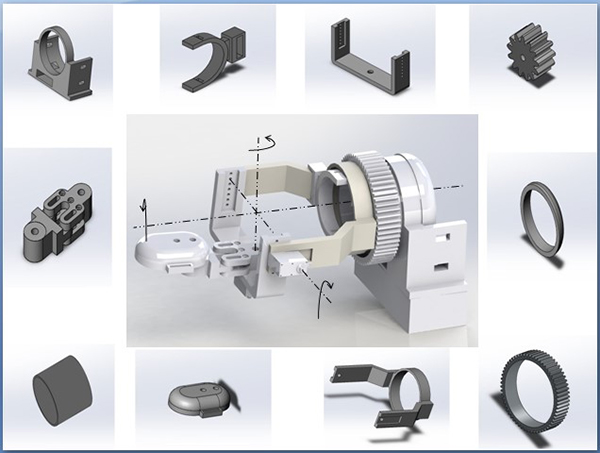
Smart Robotic Exoskeleton: a 3-DOF for Wrist-forearm Rehabilitation
Abstract
Keywords
Full Text:
PDFReferences
Zeiler S.R., and Krakauer J.W., "The interaction between training and plasticity in the poststroke brain", Curr Opin Neurol, 26(6), pp. 609–16, 2013.
O’Sullivan S., Schmitz T.J., and Fulk G., "Physical rehabilitation",(F.A. Davis Co., PA), 6th ed., pp. 664-667, 2014.
Krebs, H. I., et al., "Robot-Aided Neurorehabilitation: A Robot for Wrist Rehabilitation", IEEE Transactions on Neural Systems and Rehabilitation Engineering, 15(3), pp. 327–335, 2007.
Mauk K. L., "Overview of rehabilitation", Rehabilitation Nursing: A Contemporary Approach to Practice, 2011.
Feys H., et al., "Early and repetitive stimulation of the arm can substantially improve the long-term outcome after stroke: a 5-year follow-up study of a randomized trial", Stroke, 35(4) pp. 924-929,2004. doi:10.1161/01.str.0000121645.44752.f7.
Patton J., Small S.L., and Rymer W.Z., "Functional restoration for the stroke survivor: informing the efforts of engineers", Top Stroke Rehabil,15(6) pp. 521-541,2008. doi:10.1310/tsr1506-521.
Yap H. K., et al., "Design and Preliminary Feasibility Study of a Soft Robotic Glove for Hand Function Assistance in Stroke Survivors", Frontiers in Neuroscience, 11, p. 547, 2017. doi:10.3389/fnins.2017.00547, 2017.
Gopura R. A. R. C., Kazuo K., Bandara D. S. V., "A brief review on upper extremity robotic exoskeleton systems", 6th International Conference on Industrial and Information Systems, ICIIS, Sri Lanka, 2011.
Rehabilitation robotic, retrieved from Wikipedia, available on https://en.wikipedia.org/wiki/Rehabilitation_robotics
RewerBambi R., McDowell S.K., and Worthen-Chaudhari L. C., "Poststroke Upper Extremity Rehabilitation: A Review of Robotic Systems and Clinical Results", Topics in Stroke Rehabilitation, 14 (6), pp. 22–44, 2007. doi:10.1310/tsr1406-22. PMID 18174114.
Marchal-Crespo L., and Reinkensmeyer D. J., "Review of control strategies for robotic movement training after neurologic injury", Journal of NeuroEngineering and Rehabilitation, pp. 6- 20, 2009. doi:10.1186/1743-0003-6-20. PMC 2710333. PMID 19531254.
Senailayake C., and Senanayake S., "Emerging robotics devices for therapeutic rehabilitation of the lower extremity," in Advanced Intelligent Mechatronics,IEEE/ ASME International Conference on. IEEE, pp. 1142-1147, 2009.
Francesco A., Tadeusz M., and James O., "Robotics for rehabilitation of hand movement in stroke survivors", Advances in Mechanical Engineering, 11(4), pp. 1–14, 2019.
Stephen H. S., and Sean P D., "Potential of robots as next-generation technology for clinical assessment of neurological disorders and upper-limb therapy", The Journal of Rehabilitation Research and Development, 48( 4), pp. 335–354, 2011.
Baldovino R. G., and Jamisola R. A., "A Study O The State Of Powered-Exoskeleto Design For Lower Extremities", In 5th International Conference on Humanoid, Nanotechnology, Information Technology, Communication and Control, Environment, and Management, 2009.
Ferris D. P., Young A. J. , "in Encyclopedia of Biomedical Engineering", Elsevier, Imprint Elsevier, 2019.
Zeeshan O. K,, Zhen G, X., and Carlo M., "Surface EMG pattern recognition for real-time control of a wrist exoskeleton",BioMedical Engineering OnLine, 9, p.41, 2010.
Omarkulov N., et al.," Preliminary mechanical design of NU-Wrist: A 3-DOF self-aligning Wrist rehabilitation robot", 6th IEEE International Conference on Biomedical Robotics and Biomechatronics (BioRob), (pp. 962-967),2016.
Al-Fahaam H., Steve D., and Samia N., "A novel, soft, bending actuator for use in power assist and rehabilitation exoskeletons" , IEEE/RSJ International Conference on Intelligent Robots and Systems (IROS), pp. 533-538,2017.
Lambelet C., et al.," The eWrist—a wearable wrist exoskeleton with sEMG-based force control for stroke rehabilitation" International Conference on Rehabilitation Robotics (ICORR), (pp. 726-733), 2017.
Ikuo Y., et al., "Wrist Rehabilitation Robot System and Its Effectiveness for Patients", Sensors and Materials, 30(8), 2018.
Kadivar Z., et al.," Robotic training and kinematic analysis of arm and hand after incomplete spinal cord injury: A case study", in 2011 IEEE International Conference on Rehabilitation Robotics.
European Federation of National Associations of Orthopaedics and Traumatology, Vol.13, 2013.
] HSU H., AND SIWIEC R. M., "FOREARM SPLINTING", STATPEARLS PUBLISHING, 2019.
Author, "Applied anatomy of the wrist, thumb and hand", Elsevier, Ltd, 2013.
Kamal R. N., Starr A., and Akelman E., "Carpal Kinematics and Kinetics", _ Elsevier, 2016.
Gopura, R. A. R. C., et al., "Developments in hardware systems of active upper-limb exoskeleton robots: A review", Robotics and Autonomous Systems, 75, 203-220, 2016.
Leal J A, Rene C, Miguel S, Remero M F and Saez L M,'' Structural numerical analysis of a three fingers prosthetic hand prototype,'', pp. 526-536 academic journal, España April 2013.
DOI: https://doi.org/10.18196/jrc.26125
Refbacks
- There are currently no refbacks.
Copyright (c) 2021 Journal of Robotics and Control (JRC)

This work is licensed under a Creative Commons Attribution-ShareAlike 4.0 International License.
Journal of Robotics and Control (JRC)
P-ISSN: 2715-5056 || E-ISSN: 2715-5072
Organized by Peneliti Teknologi Teknik Indonesia
Published by Universitas Muhammadiyah Yogyakarta in collaboration with Peneliti Teknologi Teknik Indonesia, Indonesia and the Department of Electrical Engineering
Website: http://journal.umy.ac.id/index.php/jrc
Email: jrcofumy@gmail.com

